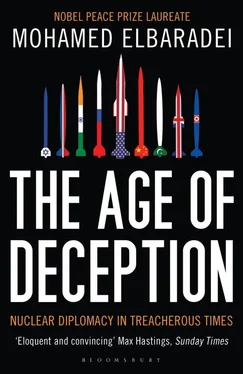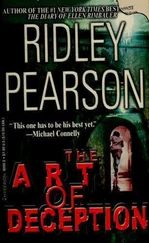On the other hand, if Iran refused the proposal, I said, it would raise concerns. They now had a significant quantity of LEU. Why would they refuse to use it for their own research reactor?
Salehi smiled as he read the paper. “This is a very smart proposal,” he said. “I wonder, would they give us yellowcake in return?” He asked this rhetorically, not really directing the question at me. [15] The Iranians were always on the lookout for ways to increase their stock of natural uranium, since they had very little of their own, and it was unlikely that anyone would sell them more under the current circumstances.
He also mused that the Iranians could be independently clever by enriching their own uranium to 20 percent and then manufacturing their own fuel. “But we will not do that,” he added quickly. He knew that such a move would inflame the issue. He was clearly intrigued and, from what I could tell, trying to consider all the possibilities at once.
“You should not look at this only as a technical proposal,” I told Salehi. “It is that, but it is also a political gesture that could open the door for negotiation.”
Salehi agreed, saying he would wait to answer until after he returned to Tehran. Worried about getting a negative answer over the phone, he wanted to explain the proposal in detail, in person, to Ahmadinejad. The atmosphere in Tehran, according to Salehi, remained tense.
I recalled that a senior Iranian official had recently told me in confidence that a power shift had taken place in Tehran. Ahmadinejad had challenged Ayatollah Khamenei on a number of fronts. While Khamenei remained the Supreme Leader in the public view, Ahmadinejad had really taken charge of the executive power.
The good news, from my perspective, was that Salehi had direct access to the Iranian president. I knew Salehi well, and as a former ambassador to the IAEA and graduate of MIT, he was sophisticated both in his technical background and his cross-cultural diplomatic skills. He knew Iran’s nuclear issues intimately. While an absolute loyalist to Iran, he was also determined to find a solution to the nuclear issues. From what I was told, his appointment to the vice presidency had been a surprise, since he had worked closely with Rafsanjani and Khatami before Ahmadinejad’s rise to power and was considered part of the liberal faction.
If ever there was to be a breakthrough, I thought, now was the time. With Obama and his team in the White House and Salehi acting as chief nuclear negotiator, both sides were genuinely interested in rapprochement. Ahmadinejad was the wild card. The constant flux in Iranian domestic politics meant that he would remain sensitive to every perceived slight. And the passing of the Bush administration did not mean that neoconservative ideology had gone away to die. Its advocates would still do their best to wreak havoc on any deal.
But at least, I thought, we finally stood a fighting chance.
News of the first wrench being thrown into the works came from French ambassador Florence Mangin. At the IAEA General Conference she told me that France agreed to fabricate the fuel for Iran after Russia would enrich it to 19.5 percent. But she said that because of its relevance to the sanctions, the fuel proposal should go to the Security Council and be woven into the political framework of the P-5+1’s deliberations. I groaned inwardly but said nothing. The approach was excessively legalistic, sure to gum up the process.
At my first opportunity, I appealed to the new U.S. ambassador, Glyn Davies, who had replaced Greg Schulte. Davies was an experienced career diplomat with a broad worldview and common sense. “Please,” I pleaded with him, “take care of this. We need this operation to go smoothly.” The provision of fuel for a research reactor, I told him, fell under the IAEA’s technical cooperation mandate. As such, there was no requirement to make it part of additional discussions at the Security Council or with the P-5+1.
Davies agreed. He said he would try to have Washington talk to Paris.
My next stop was New York: the UN Security Council Summit on Nuclear Non-Proliferation and Nuclear Disarmament, hosted by Obama. When I arrived on September 21, there was a request from U.S. undersecretary of state Bill Burns to see me, together with his colleagues Bob Einhorn [16] Special adviser for nonproliferation and arms control at the U.S. State Department.
and Gary Samore. [17] Special assistant to the president and White House coordinator for arms control and weapons of mass destruction, proliferation, and terrorism.
I had first met Burns when he was ambassador to Russia and had quickly realized why he had a reputation as one of the finest career foreign service officers in the United States: he was sharp, humble, soft-spoken, and straightforward. I had also worked closely with Einhorn and Samore for over twenty years, both when they were part of the Clinton administration and when they were in think tanks during the Bush era. [18] Einhorn had come to see me with Tom Pickering—another fine career diplomat—during the Bush administration, when they were working on the report of the bipartisan Iraq Study Group led by James Baker and Lee Hamilton.
They were two of the top U.S. experts on nonproliferation, in addition to being close friends. I went to see them at the Waldorf Astoria, where Obama was staying. The customary buzz of the Big Apple was subdued. Everything was in lockdown bunker mode because of security concerns for the summit.
Burns opened candidly: the United States was “stuck” on Iran. They saw the proposed fuel deal as an escape route; if it failed, they would be forced to move on further sanctions. Burns was keen to set a date to meet with Iran on the proposal. I told him I was working to pin down the logistics.
Then I mentioned that at Schwechat Airport in Vienna, just before flying out, I had received a cryptic letter from Iran. The gist of the message was that Iran was constructing another pilot enrichment plant. This was prefaced by an odd statement about Iran’s need to exercise passive defense and protect its human resources. I showed Burns, Einhorn, and Samore the letter, and Einhorn took a few notes.
An urgent request came the next morning: Gustavo Zlauvinen, head of the IAEA’s New York office, had gotten a call from Einhorn, who needed to see me that night at my hotel together with Samore. I was jetlagged and preparing for the summit, so I called Einhorn to ask the reason for the proposed visit.
Without preamble, he said they had known for two years about the Iranian facility under construction. A team representing the U.S., French, U.K., and Israeli intelligence agencies was preparing to go to Vienna to brief the Agency’s technical experts. He thought that he and Samore should tell me what they knew ahead of the Vienna briefing.
I asked why the IAEA had not been told before. It was yet another example of information being shared with the Agency selectively, at the time of the supplier’s choosing. They had not been sure of the nature of the facility, Einhorn said, which sounded like a bogus excuse. I suspected they were hoping to catch Iran operating the facility, giving the United States a “gotcha” situation to bolster their accusation that Iran had a nuclear weapons program. I was not pleased. Einhorn and I agreed to meet the following day, after the council meeting.
The new Iranian facility was located at Fordow, roughly thirty kilometers north of the city of Qom. The Americans claimed it was small, built to house just three thousand centrifuges, which, in their view, meant that it was not intended for industrial use and was therefore designed for military purposes. Iran, they said, had known since the spring that Western countries were onto the facility. This, they believed, was why the Iranians had finally decided to declare it to the IAEA.
Читать дальше












